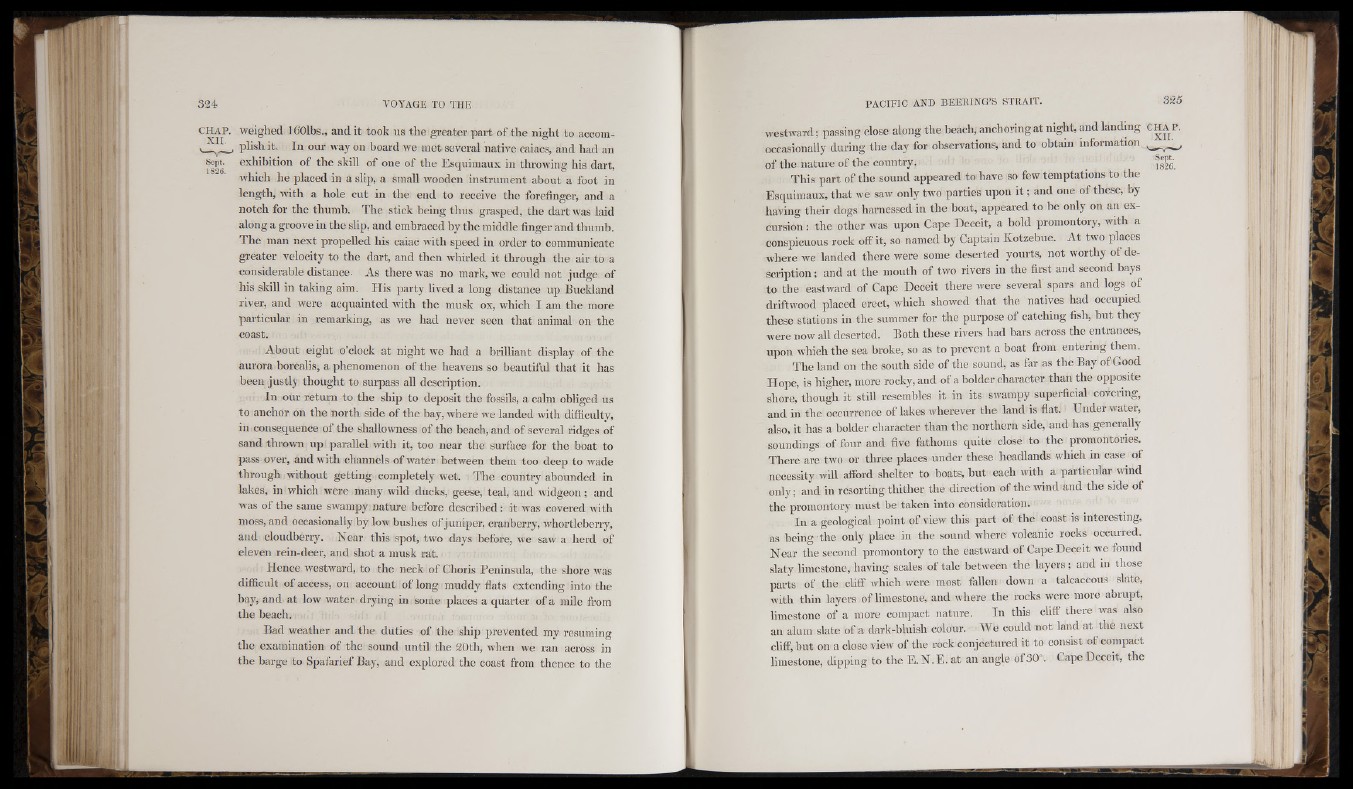
a : ‘l
-11
ii:ll
C H A P .
X I I
Sept.
1826.
weighed ICOlbs., and it took us the greater part of the night to accomplish
it. In our way on board we met several native caiacs, and had an
exhibition of the skill of one of the Esquimaux in throwing his dart,
which he placed in a slip, a small wooden instrument about a foot in
length, with a hole cut in the end to receive the forefinger, and a
notch for the thumb. The stick being thus gra.sped, the dart was laid
along a groove in the slip, and embraced by the middle finger and thumb.
The man next propelled his caiac with speed in order to communicate
greater velocity to the dart, and then whirled it through the air to a
considerable distance. As there was no mark, we could not judge of
his skill ill taking aim. His party lived a long distance up Buckland
river, and w'ere acquainted with the musk ox, which I am the more
particular in remarking, as we had never seen that animal on the
coast.
About eight o’clock at night we had a brilliant display of the
aurora borealis, a phenomenon of the heavens so beautiful that it has
been justly thought to surpass all description.
In our return to the ship to deposit the fossils, a calm obliged us
to anchor on the north side of the bay, where we landed with difficulty,
in consequence of the shallowness of the beach, and of several ridges of
sand thrown up parallel with it, too near the surface for the boat to
pass over, and with channels of water between them too deep to wade
through without getting completely wet. The country abounded in
lakes, in which were many wild ducks, geese, teal, and widgeon ; and
W'as of the same swampy nature before described: it w'as covered with
moss, and occasionally by low bushes of juniper, cranberry, whortleberry,
and cloudberry. Near this spot, two days before, we saw a herd of
eleven rein-deer, and shot a musk rat.
Hence ivestward, to the neck of Choris Peninsula, the shore was
difficult of access, on account of long muddy flats extending into the
bay, and at low water drying in some places a quarter of a mile from
the beach.
Bad weather and the duties of the ship prevented my resuming
the examination of the sound until the 20th, when we ran across in
the barge to Spafailef Bay, and explored the coast from thence to the
westward; passing close a l o n g the beach, anchoring at night, and landing C H A P .
occasionally during the day for observations, and to obtain information
of the nature of the country.
Sept.
1826.
This part of the sound appeared to have so few temptations to the
Esquimaux, that we saw only two parties upon i t ; and one of these, by
having their dogs harnessed in the boat, appeared to be only on an excursion
: the other was upon Cape Deceit, a bold promontory, with a
conspicuous rock off it, so named by Captain Kotzebue. At two places
where we landed there were some deserted yourts, not worthy of description
; and at the mouth of two rivers in the first and second bays
to the eastward of Cape Deceit there were several spars and logs of
driftwood placed erect, which showed that the natives had occupied
these stations in the summer for the purpose of catching fish, but they
were now all deserted. Both these rivers had bars across the entrances,
upon which the sea broke, so as to prevent a boat from entering them.
The land on the south side of the sound, as far as the Bay of Good
Hope, is higher, more rocky, and of a bolder character than the opposite
shore,’ though it still resembles it in its swampy superficial covering,
and in the occurrence of lakes wherever the land is flat. Under water,
also, it has a bolder character than the northern side, and has generally
soundings of four and five fathoms quite close to the promontories.
There are two or three places under these headlands which in case of
necessity will afford shelter to boats, but each with a particular wind
only; and in resorting thither the direction of the wind and the side of
the promontory must be taken into consideration.
In a geological point of view this part of the coast is interesting,
as being the only place in the sound where volcanic rocks occurred.
Near the second promontory to the eastward of Cape Deceit we found
slaty limestone, having scales of talc between the layers; and in those
parts of the cUff which were most fallen down a talcaceous slate,
with thin layers of limestone, and where the rocks were more abrupt,
limestone of a more compact nature. In this cliff there was also
an alum slate of a dark-bluish colour. YY"e could not land at the next
cliff, but on a close view of the rock conjectured it to consist of compact
limestone, dipping to the E .N .E . at an angle ofSO". Cape Deceit, the